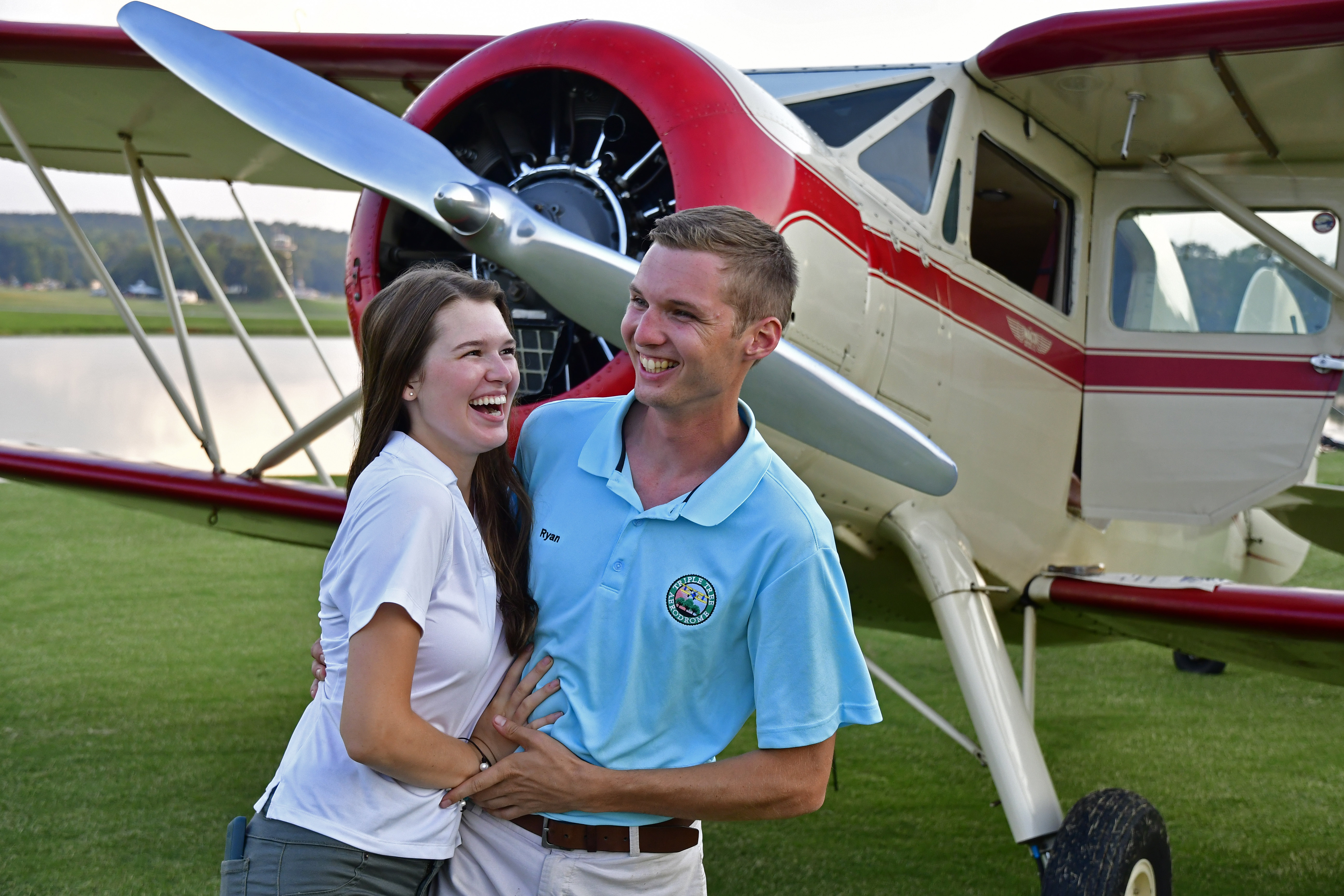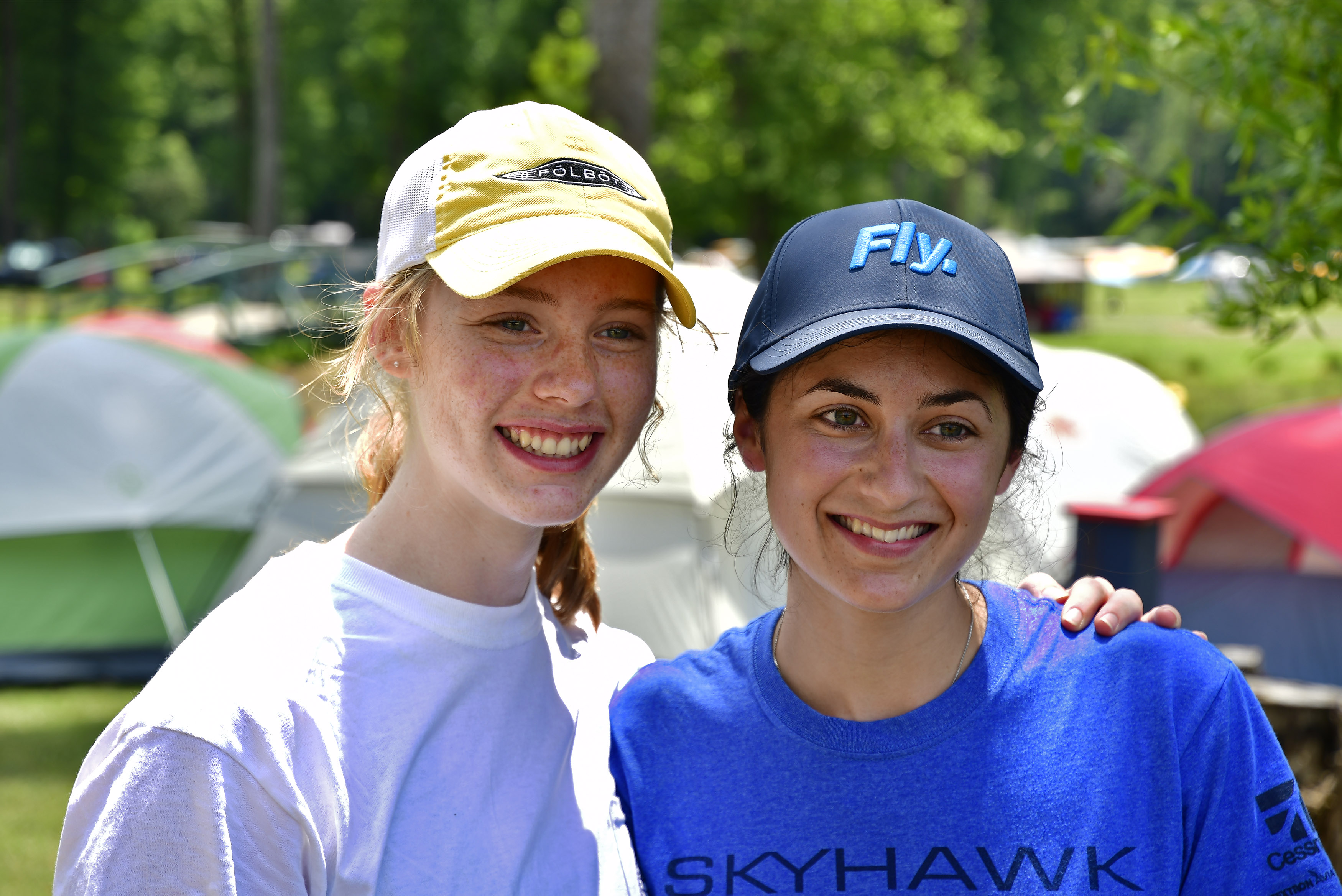Young Aviators Fly-In a ‘huge success’
Hundreds fly, drive to South Carolina's Triple Tree Aerodrome
A crowd of several hundred young and young-at-heart aviators cooked their own hamburgers on grills amid a spectacular sunset during the inaugural grassroots Young Aviators Fly-In at Triple Tree Aerodrome near Woodruff, South Carolina, June 8 to 10. An immaculately manicured 7,000-foot-long grass landing strip with upscale camping facilities, ponds, and bridges set the stage for aerobatic RC demonstrations, learning clinics, a raffle, rows and rows of airplanes, and camaraderie. More than 500 attendees registered for the low-cost, youth-oriented fly-in aimed at—and organized by—youth who are seen as vital to the future of aviation.
When AOPA learned of the fly-in, we immediately made plans to attend. Three of us flew from Maryland in a Cessna 182 loaded to the headliner with camping gear, cameras, and giveaways. Social media director John Munn thanked volunteers, staff, and attendees as burgers sizzled nearby while AOPA Air Safety Institute video producer Tyler Pangborn documented the event.
McLeod came to the attention of Triple Tree patriarch Pat Hartness after McLeod, then 17, delivered a touching eulogy for Candler Field Museum Youth Aviation Program founder Ron Alexander. He was killed in an aviation accident at his Peach State Aerodrome grass landing strip in Georgia a year after giving McLeod her first flight. She referred to mentor Alexander “as a grandfather in many ways” and initiated a wristband fundraiser to keep his youth education dreams alive.

Hartness said he was so moved by McLeod’s remembrances and her actions that he “just had to meet this young lady.” He pledged his support if he could ever help her out.
McLeod is a grass field “tailwheel girl” at heart, but she completed her private pilot certificate at a paved runway south of Atlanta, and that’s where she met commercial pilot Ryan Hunt, 23, a third-generation aviator, who would become a co-organizer.
At about the same time, Triple Tree was ramping up its weekend youth aviation programs and the three worlds conveniently collided. Hartness invited the aviators “to come up for a private tour and we loved it,” McLeod said. “They spoke to us about finding a way to get more youth involved at Triple Tree and we determined that a youth fly-in would be a great idea.” She and Hunt visited several times to solidify details. In late February, they finalized the fly-in, with news articles and social media posts leading the way.
The turnout was “awesome” said Hunt as he surveyed what he and McLeod hoped would become an annual “young person’s Oshkosh”: Free camping; meals sponsored by AOPA, the Experimental Aircraft Association, and the Academy of Model Aeronautics; plus a variety of activities and seminars aimed specifically at youth led the way.

Benson, North Carolina, CFI Sean Reagin, 19, pushed his 1939 Aeronca Chief into a parking spot under a stand of tall hardwoods. “I’m drawn to something cool like this,” he said, as he dodged the blazing sun under the wing of his green 65-horsepower liaison aircraft. “I came down here to be with people like me,” he noted. Reagin had his sights set on a floatplane position in Florida but postponed the job interview to attend the fly-in.
Middle Tennessee State University aerospace student Alan Bowers flew his dad’s Cessna Skylane from Peachtree City, Georgia, to Triple Tree so he could camp with fellow aviators. “I just wanted to hang out this weekend,” he said. Bowers is friends with Hunt and McLeod and noted that “it’s a great time for those of us in our early 20s to get into aviation.”
Lakeland Aero Club director Michael Zidziunas escorted six high school students from central Florida in two Piper Cubs and two land vehicles. “When you’re flying 70-year-old airplanes across some distances, it’s good to have chase vehicles,” he confided. The group set up a circle of seven pop-up tents near a centrally located gazebo that was perfect for airplane watching activities—and close to the wood-paneled restrooms. Zidziunas said the club would fly four vintage aircraft to EAA AirVenture in July, and he proudly added that two female students would soon attend the University of North Dakota’s aeronautical program.
Wisconsin CFI Nathan Borlee flew commercially to South Carolina because he wanted to get to know other young people and he figured the fly-in would provide that opportunity. He also explained that aviation held a variety of career positions for young people seeking professional careers. “Airlines aren’t the only option,” he noted. “We need pilots and mechanics, we need engineers, we need marketing professionals, and we need business people. There’s so many ways to get into aviation.” Borlee predicted the initial young people’s fly-in would be the beginning of a national trend. “I think local events of this caliber across the country would be really popular. We need them in Wisconsin, Montana, Wyoming, and Hawaii—we need them all over” the United States.

North Carolina’s Malena Modirzadeh, 20, said that as a child she would “look up in the sky and say to myself, ‘Oh yeah, I have to do that, I have to be a pilot someday.’” Her father purchased a discovery flight that lit the fire for her and led to a private pilot certificate. The Asheville-Buncombe Technical Community College graduate plans to earn her instrument rating and her commercial certificate before the fall and wants to become an airline pilot. “Don’t let anybody say you can’t do it because if I can do it, anyone can. You just have to network and get yourself out there.”
Modirzadeh was walking to a seminar with her new friend Rachel Enggasser when the two young women stopped to chat near the airfield’s central gathering area. They met during volunteer shifts at the fly-in and then found out they shared common interests. Enggasser’s brother Adam was awarded an AOPA High School Flight Training Scholarship in 2016, and the siblings formed the remote-controlled Upstate South Carolina Youth Aviators Association.

“This is beautiful, take a look around,” said a beaming Hartness, the creator of the idyllic airstrip and camping area that annually attracts thousands to its various RC and “full scale” fly-ins. “We are really proud to have young people here because they are the future. We want you, we need you—and we want you to like this place,” he said, welcoming attendees to his little slice of aviation heaven.
As if on cue, young people ate, talked, snapped photos, and shared instant memories in front of a red-and-cream Waco YKS-6 Cabin biplane parked on a grassy hilltop. Families sat side by side with seasoned aviators who regaled them with hangar tales during the AOPA cookout.
An evening aerobatic RC demonstration captured the attention of young and veteran aviators alike. The “blatt, blatt, blatt” of RC aircraft punctured the night air in front of the spectators’ gazebo while the aircraft hung from its propeller, twisting and squirming like a snake, as it was directed through barrel rolls, spins, and wing-overs. The aircraft was so large that two handlers captured it at the end of the routine.

Other attendees took in an aviation-themed movie at one of the several hangars that also served as learning centers throughout the weekend with events that included presentations by the Warbirds of America, the Vintage Aircraft Association, and more. Earlier in the day, about 50 youth were introduced to aviation through the EAA’s Young Eagles flight program.
Hartness said he was thrilled to host the budding event, and he vowed to help it grow and prosper. “We’re really proud to have young people here,” he said as he took in the view of a hillside with young people talking about and soaking up aviation. “This is all for you,” he reminded the attendees. “Fun, fellowship, and hospitality are the reasons we’re here. We want to give you a reason to come back next year—and the year after that. Let’s keep doing it, let’s make it happen.”
AOPA has several programs in place to ensure a robust future for aviators. The goal of AOPA’s You Can Fly High School Initiative is to help build and sustain aviation-based STEM programs and provide a quality workforce to the aviation industry. AOPA also supports flying clubs, Rusty Pilots seminars, and other pilot-support mechanisms that make flying safe, fun and affordable.














